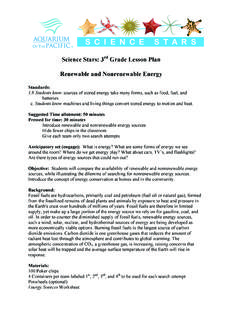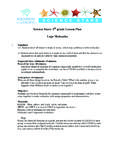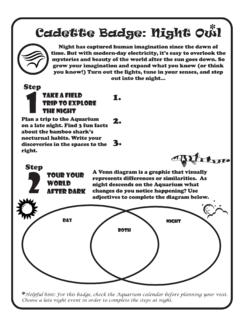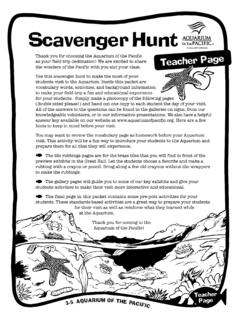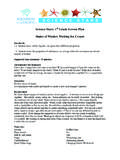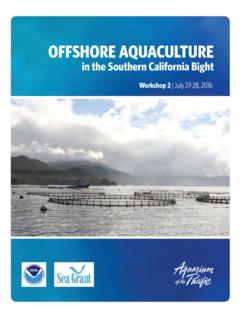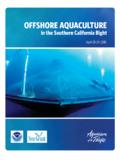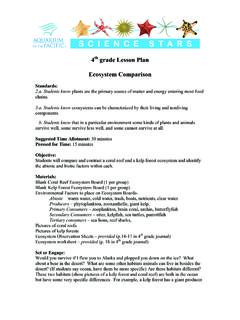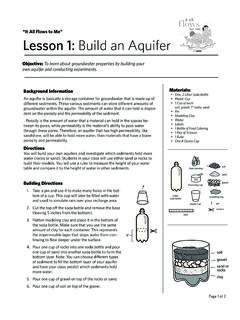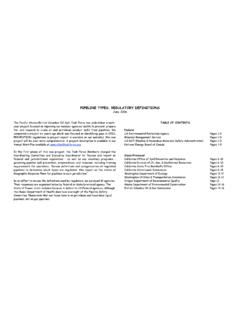Transcription of What is pollution?
1 what is pollution ? Basic Definition: pollution is a negative/undesirable change in the environment, usually the addition of something hazardous or detrimental. EPA Definition: The presence of a substance in the environment that because of its chemical composition or quantity prevents the functioning of natural processes and produces undesirable environmental and health effects. Under the Clean Water Act, for example, the term has been defined as the man-made or man-induced alteration of the physical, biological, chemical, and radiological integrity of water and other media. How many types of pollution affect the environment? There are 2 different types of pollution and they are called . Point Source pollution Non-point Source pollution Each slightly affects the environment differently.
2 So, what is point source pollution and how does it affect the environment? Basic Definition: Point source pollution is the type of pollution that can be easily tracked back to its source. You can identify (point to) the source of this pollution . Advanced Definition: Point Source pollution is pollution caused from a stationary location or fixed facility where pollutants are discharged; any single identifiable source of pollution . Examples: Chemicals Coming Out of Pipes: Pipes are stationary objects and some of them are connected to fixed facilities or buildings. People own these locations, so we have information on where the pollution that travels down these pipes comes from. oil spill from Ship: We usually think of ships as being non- stationary locations.
3 However, the ships that cause large scale oil spills are generally in bad condition and have lost the ability to be driven. Some ships may have mechanical problems that cause them to sink and become stationary on a grid coordinate system. Oil spills are easily traceable to these stationary ships. Smoke from a Factory: Often times, dark air in the sky can be traced back to tall cylinder tubes called smokestacks that are stationary parts of buildings. If you follow the trail of the dark air back to the smoke stack, then you will find out who is causing the pollution . Effects of Point Source pollution : This type of pollution immediately may destroy habitats or kill life on large scales, because it is concentrated amounts of pollution . Case Study: Exxon Valdez oil spill In 1989, Exxon the oil company had an oil carrying ship called the Exxon Valdez which hit a reef in Alaska.
4 This ship was carrying over 53,094,510 gallons of oil and spilled 11. million gallons of its load into the Pacific Ocean. This is the equivalent to 125 Olympic sized swimming pools. This oil spill stretched down 470 miles south of the actual location and harmed more than 9,000 miles of shoreline. The company spent billion dollars over 4 years before they stopped their efforts, so not all the beaches were cleaned up. Many people, fish, birds, mammals, and habitats were affected by this oil spill . Birds were affected: 250 Bald Eagles Died - This species is now recovering. 395 Loons Died - 4 species were affected, but the Common Loon population has not recovered yet. 30,000 Common Murre Died - This species is now recovering. 838 Cormorants Died - 3 species were affected, and each of population has not recovered yet.
5 Many more avian species also died and are still affected by this spill today. Marine mammals were affected: 300 Harbor Seals Died - This species has not recovered. 1,000 Sea Otters Died - This species is currently recovering. 12 River Otters Died - This species has recovered. 14 Orca Whales disappeared from a pod of 36 animals after this oil spill and no young have been added to this pod since the spill . Since the government could easily identify the source of this pollution , the company was taken to court by the federal government for criminal and civil cases. The outcome of this resulted in the government prohibiting this ship from returning to the Prince William Sound (site of oil spill ) and has led Exxon to create oil spill prevention material.
6 So, what is nonpoint source pollution and how does it affect the environment? Basic Definition: Non-point source pollution is the type of pollution that cannot be easily tracked back to its source. You cannot identify (point to) the source of this pollution ; this type of pollution happens everyday in all communities. Individuals must be responsible for their own actions, because we cannot identify who these polluters are. Non-point source pollution is more frequent than point source pollution and is the type of pollution that is responsible for harming most of the animals in the ocean. Advanced Definition: pollution that comes from diffuse sources ( without a single point of origin or not introduced into a receiving stream from a specific outlet).
7 The pollutants are generally carried off the land by storm water. Common non-point sources are agriculture, forestry, urban, mining, construction, dams, channels, land disposal, saltwater intrusion, and city streets. Examples: Motor Oil: Oil is harmful for many reasons. It acts as a poison if ingested or inhaled by animals. Oil may also foul fur on marine mammals or feathers on birds, which may make it impossible for some types of marine mammals to stay warm. The Washington Department of Ecology estimated that over million gallons of used oil are dumped into Washington State each year. This is only one state, and the amount of oil totals almost as much as the Exxon Valdez spill that only occurred once. This type of non-point source pollution occurs every year when people don't fix leaky cars, refuse to clean up small spills, and purposefully dump oil down a drain.
8 Trash: Some animals in the ocean mistake trash for food and when these animals eat trash they can become very ill. Animals like the Leatherback Sea Turtle often mistake trash for their prey items and sometimes try to eat plastic bags, mistaking them for sea jellies (their prey). Other animals may become entangled by trash. For instance, some animals get their mouths and necks caught in six-pack soda rings. Animal Waste: Sick animals carry germs and release these germs through waste (poop). These animals live in different environments and are exposed to different types of germs. Overtime species in particular habitats develop immunity to certain viruses and survive exposure to these viruses. However, if a new virus is introduced, then an animal may lack the antibodies to fight it and may die from this illness.
9 Unfortunately, some pet owners continue to choose not to pick up after their cat who decided to squat on their neighbor's front lawn instead of their litter box or the dog who they took on a walk but didn't pick up after. Pesticides: Pesticides are any substance or mixture of substances that is intended to prevent, destroy, repel, or kill any unwanted form of life. Some pesticides are cancer causing in animals and people. Often times, they may affect more life forms than the targeted pest. Fertilizers: In order for plants to grow they need water, sunlight, and nutrients. Some gardeners give their plants extra nutrients by adding fertilizer to their lawns and flowerbeds; however, this same fertilizer can also stimulate growth in marine plants (including algae).
10 When algae are exposed to extra nutrients it can result in an algal bloom (excessive growth of plants). Algae growth can significantly reduce the amount of oxygen in the ocean, because this large amount of algae will eventually die and become decomposed by bacteria. Bacteria take oxygen out of the ocean and use it to decompose biological materials. Therefore, decomposing plant material from an algal bloom can remove a large portion of oxygen from the ocean. Effects of Non-point Source pollution : This type of pollution kills more animals and plants in the ocean than point source pollution . This type of pollution does not always immediately destroy habitats or kill large amounts of life at one time. Habitats are usually destroyed over longer periods of time.
